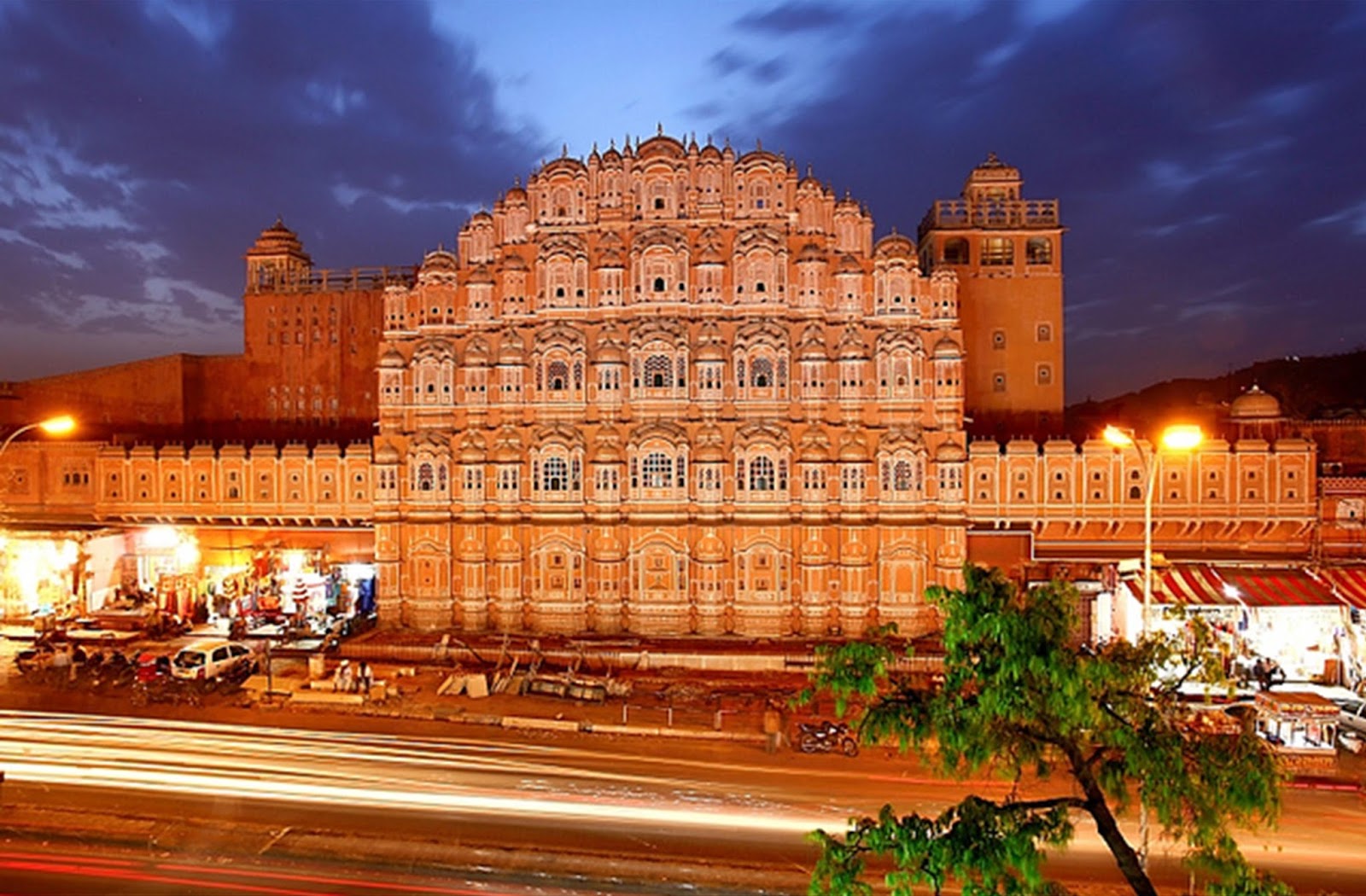Palace of Wind(Hawa Mahal)
Address : Hawa Mahal Road, J.D.A. Market, Jaipur, Rajasthan, 302002
Palace of Wind (Hawa Mahal) is easily one of Jaipur’s most iconic attractions. This stunning red and pink sandstone structure in the heart of the Pink City features rows of carved screens and more than 900 lattice-worked windows that allow in just the right amount of breeze to keep the 5-story complex cool.

With unusual Rajput architecture often likened to a honeycomb, this structure was artistically built in 1799 by Maharaja Sawai Pratap Singh as a safe place for royal ladies to watch street scenes unfold without being seen (in those days, royal women were traditionally kept out of the public eye). It’s called palace of winds because of its layout, which allows air to circulate throughout the complex, keeping temperatures cool.
Most group and private tours of Jaipur (including half-day and full-day tours, plus Golden Triangle tours that visit Jaipur and Agra) stop outside for photo opportunities, and a few include tours of the simpler interior, where there are a small museum and unparalleled views from the top. Composite tickets that allow access to a number of sights—including Amber (Amer) Fort, Albert Hall, Nahargarh Fort, and the Jantar Mantar—are available at the ticket counter.
Jal Mahal (Water Palace)
Address: Amer, Jaipur, Rajasthan, 302002
Situated smack in the middle of Man Sagar Lake, on the road that runs between Jaipur and Amber Fort (Amer Fort), the 18th-century Jal Mahal (Water Palace) is a gorgeous red sandstone palace that’s accessible only by boat. Though currently closed to visitors, the dreamlike structure is still an incredible sight to behold from shore.

The Jal Mahal Palace is an architectural showcase of the Rajput style of architecture (common in Rajasthan) on a grand scale. The building has a picturesque view of Man Sagar Lake, but owing to its seclusion from land is equally the focus of a viewpoint from the Man Sagar Dam on the eastern side of the lake in front of the backdrop of the surrounding Nahargarh ("tiger-abode") hills. The palace, built with local sandstone, is a three-storied building, with the third floor only existing on the eastern side of the palace. The eastern side is not visible from the road side public promenade, which is the Western side of the palace. The additional lower levels of the eastern side remain underwater when the lake is full. The Jal Mahal has a terrace floor with a garden, and the garden has four Tibaris facing north, south, east and west. The Tibaris are designed in the Bengal roof style architecture while the four octagonal Chhatri on the roof mark the corners of the monument. The palace had suffered subsidence in the past and also partial seepage (plaster work and wall damage equivalent to rising damp) because of water logging, which have been repaired under a restoration project of the Government of Rajasthan.
Amber Fort (Amer Fort)
Address: Sansar Chandra Road, Jaipur, Rajasthan, 302001
High on a hilltop, towering majestically over the village of Amber on the outskirts of Jaipur, this 16th-century fort palace is worth visiting for its grand architecture that blends Muslim Mughal and Indian Hindu (Rajput) elements. Here, you’ll find labyrinthine passageways, elegant royal halls, and fabulous views of desert landscape.

Amer Fort or Amber Fort is a fort located in Amer, Rajasthan, India. Amer is a town with an area of 4 square kilometres (1.5 sq mi) located 11 kilometres (6.8 mi) from Jaipur, the capital of Rajasthan. Located high on a hill, it is the principal tourist attraction in Jaipur.Amer Fort is known for its artistic style elements. With its large ramparts and series of gates and cobbled paths, the fort overlooks Maota Lake,which is the main source of water for the Amer Palace.
Amer Palace is great example of Rajput architecture. Some of its buildings and work have influence of Mughal architecture. Constructed of red sandstone and marble, the attractive, opulent palace is laid out on four levels, each with a courtyard. It consists of the Diwan-e-Aam, or "Hall of Public Audience", the Diwan-e-Khas, or "Hall of Private Audience", the Sheesh Mahal (mirror palace), or Jai Mandir, and the Sukh Niwas where a cool climate is artificially created by winds that blow over a water cascade within the palace. Hence, the Amer Fort is also popularly known as the Amer Palace. The palace was the residence of the Rajput Maharajas and their families. At the entrance to the palace near the fort's Ganesh Gate, there is a temple dedicated to Shila Devi, a Goddess of the Chaitanya cult, which was given to Raja Man Singh when he defeated the Raja of Jessore, Bengal in 1604. (Jessore is now in Bangladesh). Raja Man Singh had 12 queens so he made 12 rooms, one for each Queen. Each room had a staircase connected to the King’s room but the Queens were not to go upstairs. Raja Jai Singh had only one queen so he built one room equal to three old queen’s rooms.


